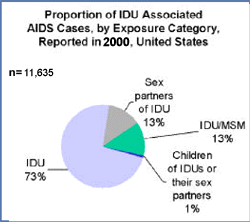|
|
|
|
|
|
||
|
Divisions of HIV/AIDS Prevention |
|||||||
Sharing syringes and other equipment for drug injection is a well known route of HIV transmission, yet injection drug use contributes to the epidemic’ s spread far beyond the circle of those who inject. People who have sex with an injection drug user (IDU) also are at risk for infection through the sexual transmission of HIV. Children born to mothers who contracted HIV through sharing needles or having sex with an IDU may become infected as well.
Racial and ethnic minority populations in the United States are most heavily affected by IDU-associated AIDS. In 2000, IDU-associated AIDS accounted for 26% of all AIDS cases among African American and 31% among Hispanic adults and adolescents, compared with 19% of all cases among white adults/adolescents. IDU-associated AIDS accounts for a larger proportion of cases among adolescent and adult women than among men. Since the epidemic began, 57% of all AIDS cases among women have been attributed to injection drug use or sex with partners who inject drugs, compared with 31% of cases among men. Noninjection drugs (such as "crack" cocaine) also contribute to the spread of the epidemic when users trade sex for drugs or money, or when they engage in risky sexual behaviors that they might not engage in when sober. One CDC study of more than 2,000 young adults in three inner-city neighborhoods found that crack smokers were three times more likely to be infected with HIV than non-smokers. Strategies for IDUs Must Be Comprehensive Comprehensive HIV prevention interventions for substance abusers must provide education on how to prevent transmission through sex. Numerous studies have documented that drug users are at risk for HIV through both drug-related and sexual behaviors, which places their partners at risk as well. Comprehensive programs must provide the information, skills, and support necessary to reduce both risks. Researchers have found that many interventions aimed at reducing sexual risk behaviors among drug users have significantly increased the practice of safer sex (e.g., using condoms, avoiding unprotected sex) among participants. Drug abuse treatment is HIV prevention, but drug treatment slots are scarce. In the United States, drug use and dependence are widespread in the general population. Experts generally agree that there are about 1 million active IDUs in this country, as well as many others who use noninjection drugs or abuse alcohol. Clearly, the need for substance abuse treatment vastly exceeds our capacity to provide it. Effective substance abuse treatment that helps people stop using drugs not only eliminates the risk of HIV transmission from sharing contaminated syringes, but, for many, reduces the risk of engaging in risky behaviors that might result in sexual transmission. For injection drug users who cannot or will not stop injecting drugs, using sterile needles and syringes only once remains the safest, most effective approach for limiting HIV transmission. To minimize the risk of HIV transmission, IDUs must have access to interventions that can help them protect their health. They must be advised to always use sterile injection equipment; warned never to reuse needles, syringes, and other injection equipment; and told that using syringes that have been cleaned with bleach or other disinfectants is not as safe as using new, sterile syringes. Having access to sterile injection equipment is important, but it is not enough. Preventing the spread of HIV through injection drug use requires a comprehensive approach that incorporates several basic principles:
Strategies for prevention should include:
Better integration of all prevention and treatment services is critically needed. HIV prevention and treatment, substance abuse prevention, and sexually transmitted disease treatment and prevention services must be better integrated to take advantage of the multiple opportunities for intervention--first, to help the uninfected stay that way; second, to help infected people stay healthy; and third, to help infected individuals initiate and sustain behaviors that will keep themselves safe and prevent transmission to others. For more information...
CDC National STD & AIDS Hotlines:
CDC National Prevention Information Network:
Internet Resources:
Centers for Disease Control & Prevention National Center for HIV, STD, and TB Prevention Divisions of HIV/AIDS Prevention Contact Us |


